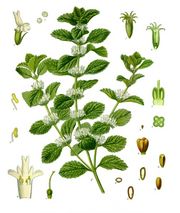Marrubium vulgare
| Marrubium vulgare subsp. var. | ||||||||||||||||||||||||||||||||||||||||||||||||||||||||
|---|---|---|---|---|---|---|---|---|---|---|---|---|---|---|---|---|---|---|---|---|---|---|---|---|---|---|---|---|---|---|---|---|---|---|---|---|---|---|---|---|---|---|---|---|---|---|---|---|---|---|---|---|---|---|---|---|

|
|
| ||||||||||||||||||||||||||||||||||||||||||||||||||||||
| ||||||||||||||||||||||||||||||||||||||||||||||||||||||||
Marrubium vulgare (White Horehound or Common Horehound) is a flowering plant in the family Lamiaceae, native to Europe, northern Africa and Asia.
It is a greyish-leaved herbaceous perennial plant, somewhat resembling mint in appearance, which grows to 25-45 cm tall. The leaves are 2-5 cm long with a densely crinkled surface, and downy-hairy. The flowers are white, borne in clusters on the upper part of the main stem. Like other members of Lamiaceae, horehound has a square stem.
Marrubium vulgare is also used as a natural grasshopper repellant in agriculture.
| Standard Cyclopedia of Horticulture |
|---|
|
Marrubium vulgare, Linn. Common Horehound. Height 1-3 ft.: sts. ascending, woolly or tomentose: lvs. ovate to round-ovate, stalked: calyx with 10 recurved teeth, the alternate ones shorter: fls. whitish. Summer.— Now found as an escape from gardens in waste places of nearly every country of the world. Horehound is used in large quantities for confections and medicines for coughs and colds.
|
Cultivation
Propagation
Pests and diseases
Varieties
Gallery
-
photo 1
-
photo 2
-
flowers
-
foliage of young plants
-
Horehound bug, a common insect that feeds on White Horehound
References
- Standard Cyclopedia of Horticulture, by L. H. Bailey, MacMillan Co., 1963
External links
- w:Marrubium vulgare. Some of the material on this page may be from Wikipedia, under the Creative Commons license.
- Marrubium vulgare QR Code (Size 50, 100, 200, 500)



